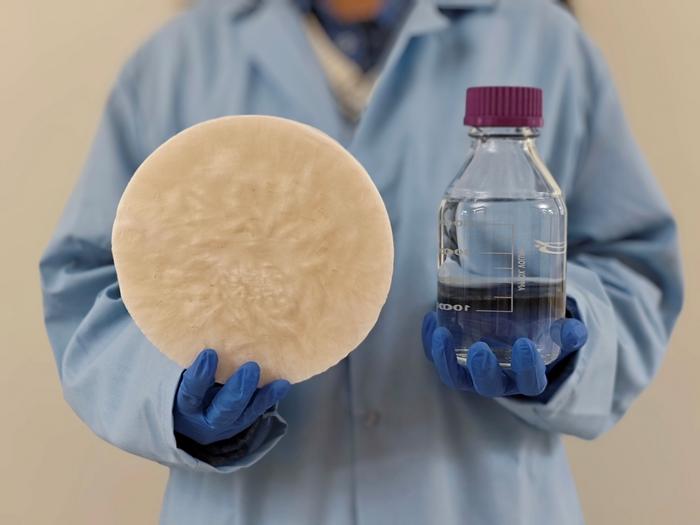In a world where one in three people lack access to safe drinking water, researchers at the University of Texas at Austin have developed an innovative solution that transforms everyday biomass – from food scraps to seashells – into materials that can extract clean drinking water directly from the atmosphere.
The new system, which the researchers call “molecularly functionalized biomass hydrogels,” can generate nearly four gallons of clean water per kilogram of material daily, even in relatively dry conditions – a significant improvement over conventional water harvesting technologies.
“With this breakthrough, we’ve created a universal molecular engineering strategy that allows diverse natural materials to be transformed into high-efficiency sorbents,” said Guihua Yu, professor of materials science and mechanical engineering at UT Austin. “This opens up an entirely new way to think about sustainable water collection, marking a big step towards practical water harvesting systems for households and small community scale.”
The research, published February 13 in the journal Advanced Materials, represents a potential solution to one of humanity’s most pressing challenges – reliable access to clean drinking water – using materials that would otherwise go to waste.
From Waste to Water
At the heart of the technology is a two-step process that converts natural polysaccharides – complex carbohydrates found in plant and animal materials – into specialized hydrogels that can absorb moisture from the air and then release it as clean water when heated.
The system works similarly to how silica gel packets prevent moisture damage in packaged products, but with significantly greater efficiency and using natural materials rather than synthetics.
In their field tests, the researchers achieved impressive results: a single kilogram of their material could produce up to 14.19 liters (3.75 gallons) of water daily. Most comparable technologies typically generate between 1 and 5 liters per kilogram per day.
What makes this approach particularly promising is its versatility. The researchers successfully demonstrated the technique using cellulose (found in plant cell walls), starch (abundant in foods like corn and potatoes), and chitosan (derived from the shells of crustaceans).
“At the end of the day, clean water access should be simple, sustainable, and scalable,” said Weixin Guan, senior doctoral student and the study’s lead researcher. “This material gives us a way to tap into nature’s most abundant resources and make water from air—anytime, anywhere.”
How It Works
The technology takes advantage of the vast reservoir of water vapor in Earth’s atmosphere – estimated at over 13,000 cubic kilometers – providing a renewable source of freshwater that isn’t dependent on rainfall or groundwater.
Unlike many existing technologies that require high humidity levels to function effectively, the UT Austin team’s materials can extract meaningful quantities of water even in relatively dry conditions.
The innovation lies in the molecular engineering approach. The researchers developed a method to modify natural polysaccharides at the molecular level, enhancing their ability to capture moisture from the air and then release it easily when heated mildly.
This two-step process involves first attaching thermoresponsive groups to the natural materials, which makes them more responsive to temperature changes. Then, the researchers add zwitterionic groups – molecules with both positive and negative charges – which enhance the materials’ ability to absorb and store water.
The result is a hydrogel that can efficiently capture moisture from the air at room temperature and then release that moisture as clean water when heated to just 60°C (140°F), a temperature achievable with solar heating or waste heat from other processes.
Sustainable by Design
Unlike many existing water harvesting technologies that rely on petrochemical-derived materials and energy-intensive processes, the new approach prioritizes sustainability at every step.
“The biggest challenge in sustainable water harvesting is developing a solution that scales up efficiently and remains practical outside the lab,” said Yaxuan Zhao, a graduate researcher involved in the study. “Since this hydrogel can be fabricated from widely available biomass and operates with minimal energy input, it has strong potential for large-scale production and deployment in off-grid communities, emergency relief efforts, and decentralized water systems.”
The biomass-based hydrogels are biodegradable and can be produced from abundant natural materials that would otherwise be discarded. The process also requires minimal energy to release the collected water, potentially allowing operation using solar energy or low-grade waste heat.
This stands in contrast to traditional water harvesting systems that often rely on refrigeration to condense atmospheric moisture, which demands significant electrical power and specialized equipment.
From Lab to Real World
The UT Austin team, which has been developing water-generating hydrogels for several years, has been focused on creating solutions that can help people lacking access to clean drinking water from the beginning.
Previous iterations of their technology have been adapted for extremely dry conditions, and Professor Yu has also developed injectable water filtration systems and applied hydrogel technology to farming.
The researchers are now working on scaling production and designing practical devices for commercialization, including portable water harvesters, self-sustaining irrigation systems, and emergency drinking water devices.
With the United Nations Sustainable Development Goals aiming to ensure universal water access by 2030, technologies like this could provide crucial support for communities in water-stressed regions, especially as climate change exacerbates water scarcity in many parts of the world.
For the roughly two billion people worldwide who lack consistent access to clean drinking water, innovations that can literally pull water out of thin air – using discarded natural materials and minimal energy – could represent a life-changing development.
As the research moves from laboratory to practical applications, it highlights how reimagining common waste materials could help address one of humanity’s most fundamental needs: access to clean, safe drinking water.
If our reporting has informed or inspired you, please consider making a donation. Every contribution, no matter the size, empowers us to continue delivering accurate, engaging, and trustworthy science and medical news. Independent journalism requires time, effort, and resources—your support ensures we can keep uncovering the stories that matter most to you.
Join us in making knowledge accessible and impactful. Thank you for standing with us!

